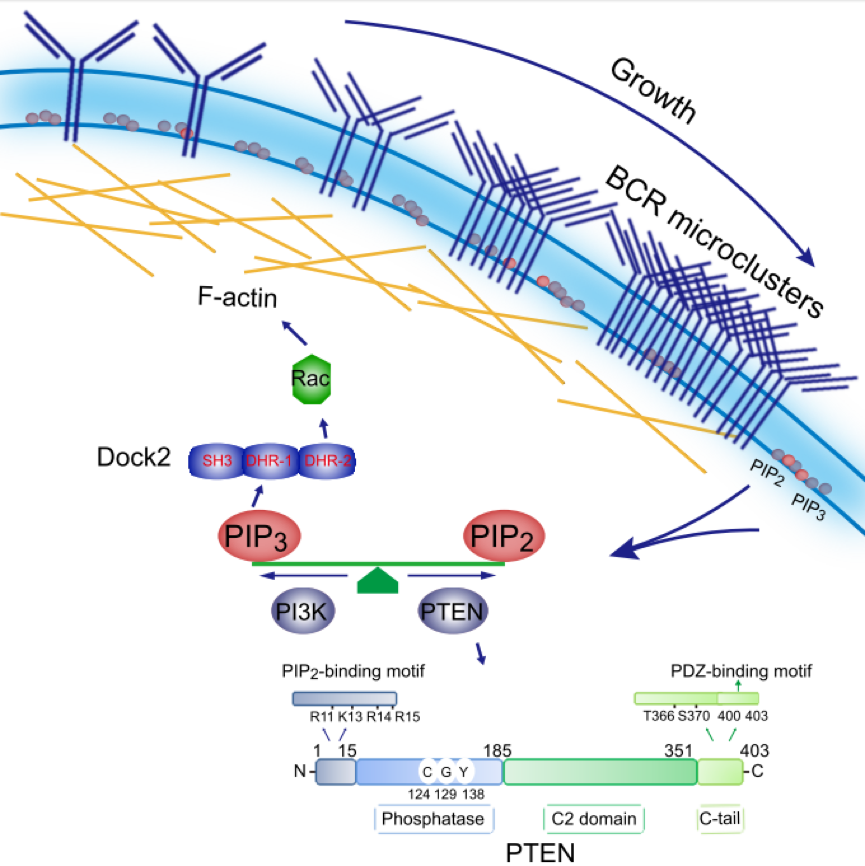|
On November 28, 2017, a research team led by Dr. Wanli Liu from School of Life Sciences, Tsinghua University published a research article entitled “Growth of B cell receptor microclusters is regulated by PIP2 and PIP3 equilibrium and Dock2 recruitment and activation” in Cell Reports. In this study, the group reported the molecular mechanism of the B cell receptor microcluster growth which was regulated by PIP2 and PIP3 equilibrium. The results showed that PI3K- and PTEN-governed PIP2 and PIP3 equilibrium regulates B cell activation through Dock2 recruitment and activation. The activated Dock2 then controls growth of BCR microclusters through remodeling of the F-actin cytoskeleton.
Surface expression of the B cell receptor (BCR) allows B lymphocytes to recognize antigens. The growth of BCR microclusters upon antigen stimulation drives B cell activation. The paper shows that PI3K-mediated PIP3 production is required for the growth of BCR microclusters. This growth is likely inhibited by PTEN and dependent on its plasma membrane binding and lipid phosphatase activities. The research found that PIP3-dependent recruitment and activation of a guanine nucleotide exchange factor, Dock2, is required for the sustained growth of BCR microclusters through remodeling of the F-actin cytoskeleton. As a consequence, Dock2 deficiency significantly disrupts the structure of the B cell immunological synapse. Lastly this research found that primary B cells from Systemic Lupus Erythematosus (SLE) patients exhibit more prominent BCR and PI3K microclusters than B cells from healthy controls. This paper demonstrates the importance of a PI3K- and PTEN-governed PIP2 and PIP3 equilibrium in regulating the activation of B cells through Dock2-controlled growth of BCR microclusters. These studies provide new insights into immune recognition, activation and regulation for B lymphocytes, and better understanding to autoimmune diseases as well as important information on the pathogenesis of related diseases, which can further lead to the better vaccine development on the basis of strong theoretical knowledge.
Dr. Wanli Liu’s group is committed to investigate the function of lymphocytes by combining immunological and biochemical experimental approaches with cutting-edge high resolution high speed live cell and molecular imaging techniques along with biophysical research methods. Following the publications in the Nature Communications and eLife in 2015, Journal of Experimental Medicine and PNAS in 2016, eLife and Science Immunology in 2017, and The Journal of Immunology (2013, 2014, 2017) about immune activation of B lymphocytes, this research is his latest contribution to this field.
Jing Wang, a Ph.D. student from School of Life Sciences, Tsinghua University, is the first author, and Dr. Wanli Liu is the corresponding author of this article. This study required a strong integration of molecular biology, cell biology, and high-resolution live cell imaging and other disciplines of cross-advantages. It involved genetically modified mice spleen B cells, autoimmune disease patient’s blood B cells and other experimental materials. During the course of the study, researchers were also supported by Dr. Wenjie Zheng from Department of Rheumatology and Clinical Immunology, Peking Union Medical College Hospital, Peking Union Medical College and Chinese Academy of Medical Sciences, and Dr. Zhanguo li and Xiaolin Sun from Department of Rheumatology and Immunology, Peking University People’s Hospital & Beijing Key Laboratory for Rheumatism Mechanism and Immune Diagnosis. The study is funded by the National Science Foundation of China, the Ministry of Science and Technology of People's Republic of China and Young Thousands Program.
Link of the paper: http://www.cell.com/cell-reports/fulltext/S2211-1247(17)31597-8

Figure. PI3K- and PTEN-governed PIP2 and PIP3 equilibrium regulates B cell activation through Dock2 controlled growth of antigen receptor microclusters
|
